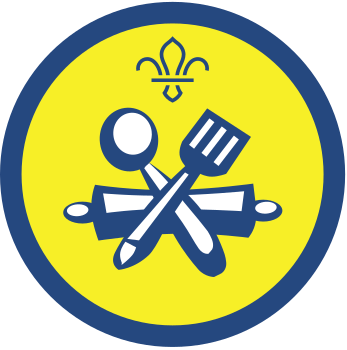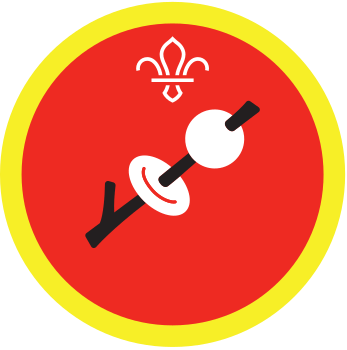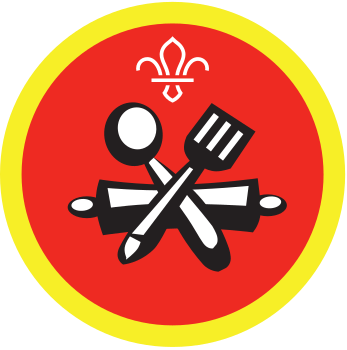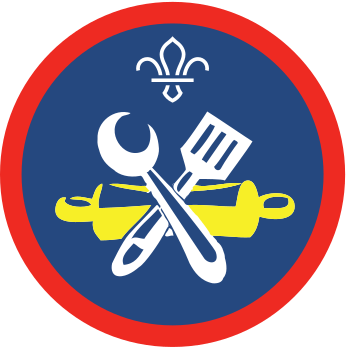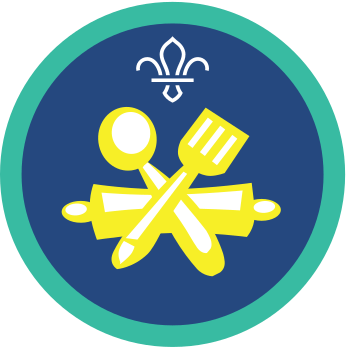
Make campfire hot-cross buns
You’ll need
- Ingredients (see recipe card)
- Large bowl (per group)
- Small saucepan (per group)
- Spoon for mixing (per group)
- Knife for mixing (per group)
- 1 zip-lock bag (per group)
- Clingfilm (per group)
- Dutch Oven (or equivalent fireproof casserole dish with lid)
- A campfire, with hot embers and coals to cook on
- Campfire grill or alternative
- PPE (protective equipment), such as heatproof gloves
- Bucket of sand and/or water
- First aid kit for burns
Before you begin
- Use the safety checklist to help you plan and risk assess your activity. Additional help to carry out your risk assessment, including examples can be found here. Don’t forget to make sure all young people and adults involved in the activity know how to take part safely.
- Make sure you’ll have enough adult helpers. You may need some parents and carers to help if you’re short on helpers.
Having a safe cooking source
- Make sure that everyone’s fires have been built outdoors in clear, open areas, with plenty of ventilation, and away from any areas where people will be sleeping.
- All the fires need to burn down to hot embers before they can start cooking. This increases the chance of the fuel burning without enough oxygen present, increasing the risk of carbon monoxide exposure. We’ve more guidance on different cooking methods.
- If using a gas stove, make sure it’s on a stable heatproof surface and in a clear and open area, with plenty of ventilation.
Building a fire and preparing to cook on a campfire
- Build and light a fire before starting this activity. Our activities, Campfire admirers or Construct a campfire, can help you to do this. You’ll use the hot embers to cook on, so the fire will need enough time to die down before cooking.
- You could run our fire safety activities, Fuel air ignition and Sitting safely by a campfire, prior to running this session.
- Remember to have a hand washing station and take extra hygiene precautions when handling food. Take a look at our guidance on food preparation.
- Make sure you have all the ingredients ready.
- Remember to check your ingredients against any allergy or dietary requirements to ensure everyone can enjoy the recipe. This may mean using alternative ingredients.
Introducing the activity
- Gather everyone in a small group and tell them that you’re going to make hot cross buns on a campfire.
- Hot Cross Buns are a traditional Easter dish. You could make this recipe as part of Easter celebrations.
- You may want to run a fire safety talk or show people how to use the equipment safely, such as for cooking or chopping ingredients, or you may need to remind everyone about ways to be safe around a campfire.
Campfire hot cross bun ingredients:
- 480g (4 cups) plain flour
- 2 x 7g sachets of dried yeast
- 115 g (1/2 cup) caster sugar
- 1 1/2 teaspoons mixed spice
- Pinch of salt
- 265g (1 1/2 cups) sultanas/currents/chocolate chips
- 40g (3 tbsp) butter, softened
- 300ml milk
- 2 eggs, lightly beaten
For the flour paste:
- 60g (1/2 cup) flour
- 5-6 tablespoons water
For the glaze:
- 79ml (1/3 cup) water
- 2 tablespoons caster sugar
Prep time: 90 minutes
Cook time: 30 minutes
Makes: 12 buns
Making the hot cross buns
- Everyone should wash their hands.
- The recipe makes 12 buns. Depending on how many people you have, you may want to split everyone into smaller groups to make their buns.
- Mix the flour, yeast, sugar, mixed spice, salt and sultanas in a large bowl.
- In a small saucepan, place the butter and milk, then heat it until it’s slightly warm.
- Add the butter and milk mixture into the bowl with your dry, flour mixture.
- Now, add the egg into the bowl and stir well, using a knife to combine the ingredients.
- Stir well until the dough starts to come together.
- You can use your hands to finish mixing everything together to make a soft dough.
- Once your dough’s formed, put some flour on a clean, flat surface.
- Put the dough out onto the floured surface and knead it until it’s smooth, then shape the dough into a ball.
- Lightly oil a bowl. It can be the same large bowl from the beginning, so long as it has been cleaned out first. Place the dough into the lightly oiled bowl and cover it with clingfilm.
- Place the bowl to one side in a warm place for an hour, or until the dough doubles in size. To save on time, an adult volunteer could make the dough before the session if needed.
- After an hour, remove the risen dough from the bowl and gently ‘punch down’. To “punch” the dough properly, firmly, but gently, push your fist into the center of the dough. Then knead the dough a few times and reform the dough into a ball.
- Divide the dough into 12 equal balls, or buns.
- Place the buns onto a greased tray, cover them with plastic wrap, then leave in a warm place to rise while an adult volunteer heats the Dutch oven. Remember to use personal protective equipment, such as heatproof gloves when handling the Dutch oven and placing it onto the campfire.
- Now it’s time to make the flour paste. To make the flour paste, mix the flour and water together in a small bowl until it’s a smooth paste. You can add a little more water to the mix if it’s too thick. Spoon the mixture into a small Ziplock bag and, when you’re ready to start piping, put off one small corner of the bag. Carefully take the buns from the warm place and pipe the flour paste to form crosses over the top of each bun.
- An adult should carefully remove your Dutch Oven from the heat, remembering to wear the heatproof gloves. They should place it down on a heatproof surface in a safe place, away from young people, and allow it to cool. An adult volunteer should place the Hot Cross Buns in the camp oven and then return it to the campfire.
- Bake the buns for roughly 25 to 30 minutes or until buns are cooked through. You can test by seeing if they sound hollow when tapped by an adult volunteer with a utensil, as this shows they’re cooked. With an adult volunteer, keep checking every 10 minutes to make sure they’ve not burnt.
- When ready, an adult should carefully remove your Dutch Oven from the heat, remembering to wear the heatproof gloves. They should place it down on a heatproof surface in a safe place, away from young people, and allow it to cool.
- Once cooled, with an adult volunteer, carefully take your Hot Cross Buns out of your Dutch oven and use safe cooking utensils to put them on a plate.
- To make the glaze, place water and sugar into a small saucepan and stir on a hob until the sugar has dissolved. Brush the warm glaze over the Hot Cross Buns.
- Divide them up into bowls or onto plates for your group to try.
- Everyone can add any toppings if they’d like them, such as butter or jam, then make sure the Hot Cross Buns have cooled down before you tuck in. Enjoy!
Putting out the fire safely and tidying up
- Once everyone has finished using the fire, no-one should add any more wood. The fire will slowly begin to die down. Ask young people to step away from the fire while it’s put out.
- Use a stick, but not one that’s been in the fire, an adult should carefully spread out the wood and embers, so they cool down quickly.
- An adult should pour water over the smouldering wood and ashes to make sure they’re fully extinguished. Use a stick to mix the water through the ashes.
- Young people should work together to clear up quickly and efficiently. Each group needs to wash up their utensils, then dispose of any rubbish. Any leftovers could be taken home to avoid waste.
Reflection
This activity was a great introduction to the fun of cooking and developing a new skill! Hot cross buns are something we often buy, so how did the experience of making them from scratch make you feel? Did you work well as a team? How did you make sure everyone got to take part? When using the campfire, how did you keep the outdoors, and each other, safe while you were cooking?
Why do you think Hot Cross Buns might be made or eaten at Easter traditionally? Did you enjoy eating them?
Did this activity give you more confidence to try making other baked goods? What may you try to make next?
Safety
All activities must be safely managed. You must complete a thorough risk assessment and take appropriate steps to reduce risk. Use the safety checklist to help you plan and risk assess your activity. Always get approval for the activity, and have suitable supervision and an InTouch process.
- Cooking
Teach young people how to use cooking equipment safely. Supervise them appropriately throughout. Make sure it’s safe to use and follow manufacturers’ guidelines for use.
- Fires and stoves
Make sure anyone using fires and stoves is doing so safely. Check that the equipment and area are suitable and have plenty of ventilation. Follow the gas safety guidance. Have a safe way to extinguish the fire in an emergency.
- Food
Remember to check for allergies, eating problems, fasting or dietary requirements and adjust the recipe as needed. Make sure you’ve suitable areas for storing and preparing food and avoid cross contamination of different foods. Take a look at our guidance on food safety and hygiene.
- Hot items and hot water
Kettles, cookers and microwave ovens produce a lot of heat by the very nature of them. Caution is needed when in contact with items that have been heated and young people should use them under adult supervision. Use on a suitable surface, protecting it if necessary. Never leave hot items unattended and make sure there’s a nearby first aid kit, with items to treat burns/scalds.
- Carbon Monoxide
Carbon monoxide (CO) is a serious risk, so make sure you cook or use appliances in a properly ventilated area. If you need a sheltered cooking area, consider an open sided gazebo, dining shelter or a marquee that has sufficient air circulation and ventilation. Take a look at our further guidance on carbon monoxide.
To save on time, an adult volunteer could make the dough before the session if needed. You may want to use an oven instead if that’s more appropriate or easier for your group.
- There are lots of different jobs that need doing when planning, making and cooking on a campfire. There’s a role for everyone, so encourage everyone to be involved in a way that works for them.
- It’s OK if some people take different roles in this activity – some people will need to collect materials, watch the fire, and start preparing the food. Anyone who finds the physical aspects tricky could help read the recipe and direct everyone else – it’s always useful to have someone keeping an eye on everything to make sure the team’s working together smoothly.
- If you don’t have enough space for a campfire or access to an oven, try using disposable barbecues or a portable fire pit, as long as you have a safe place to use them.
- Make sure you've checked everyone's dietary requirements and allergies then adapted the recipe as appropriate.
- If someone’s struggling with the baking section of this activity, they could work with a partner, so they can help each other.
All Scout activities should be inclusive and accessible.
Using the same base, are there any other ingredients that you think would make a yummy hot cross bun? Try designing your own or try making a Hot Cross Bun in a mug.

